History of nursing and professional organization PDF
VerifiedAdded on 2021/12/09
|5
|1245
|106
AI Summary
Contribute Materials
Your contribution can guide someone’s learning journey. Share your
documents today.
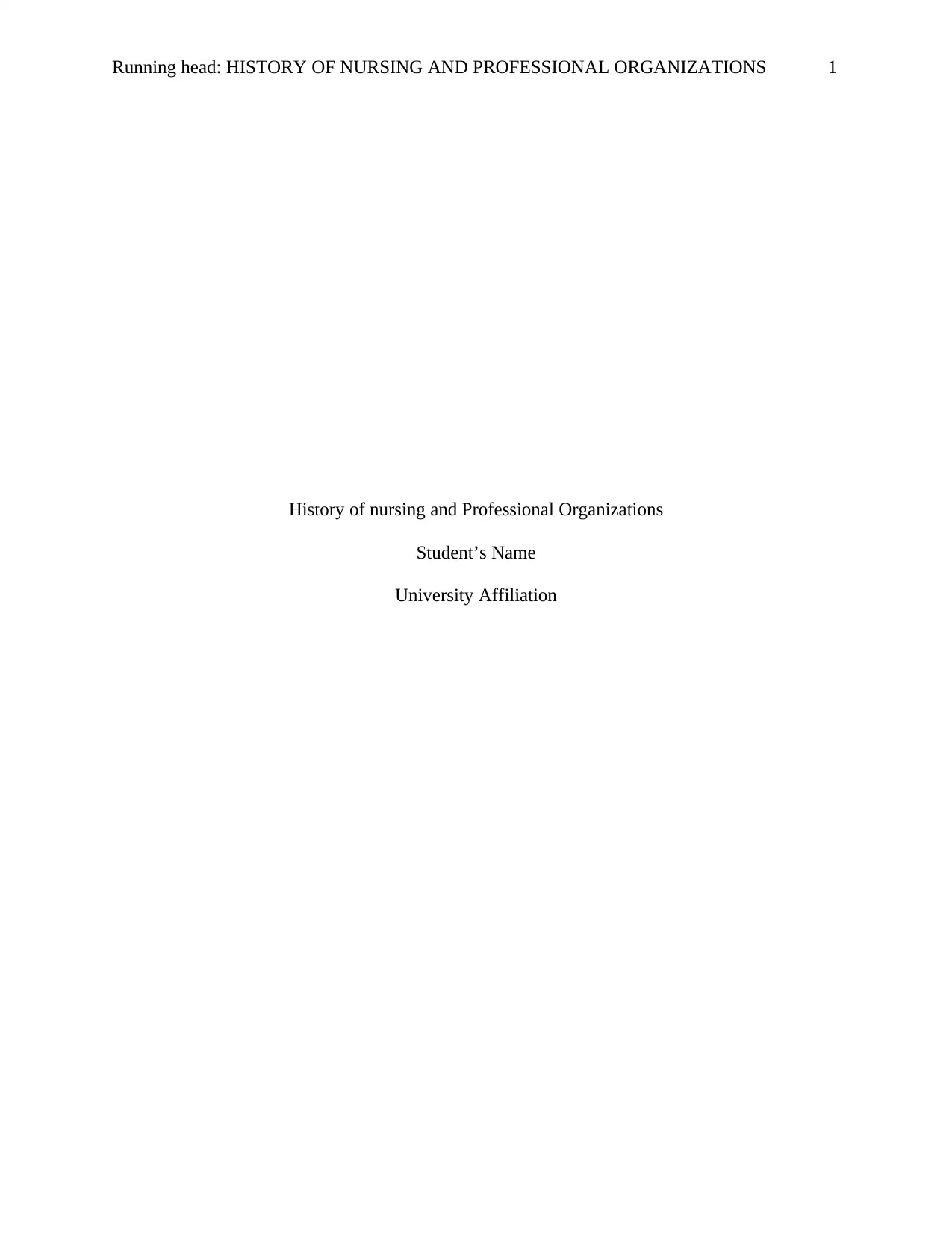
Running head: HISTORY OF NURSING AND PROFESSIONAL ORGANIZATIONS 1
History of nursing and Professional Organizations
Student’s Name
University Affiliation
History of nursing and Professional Organizations
Student’s Name
University Affiliation
Secure Best Marks with AI Grader
Need help grading? Try our AI Grader for instant feedback on your assignments.
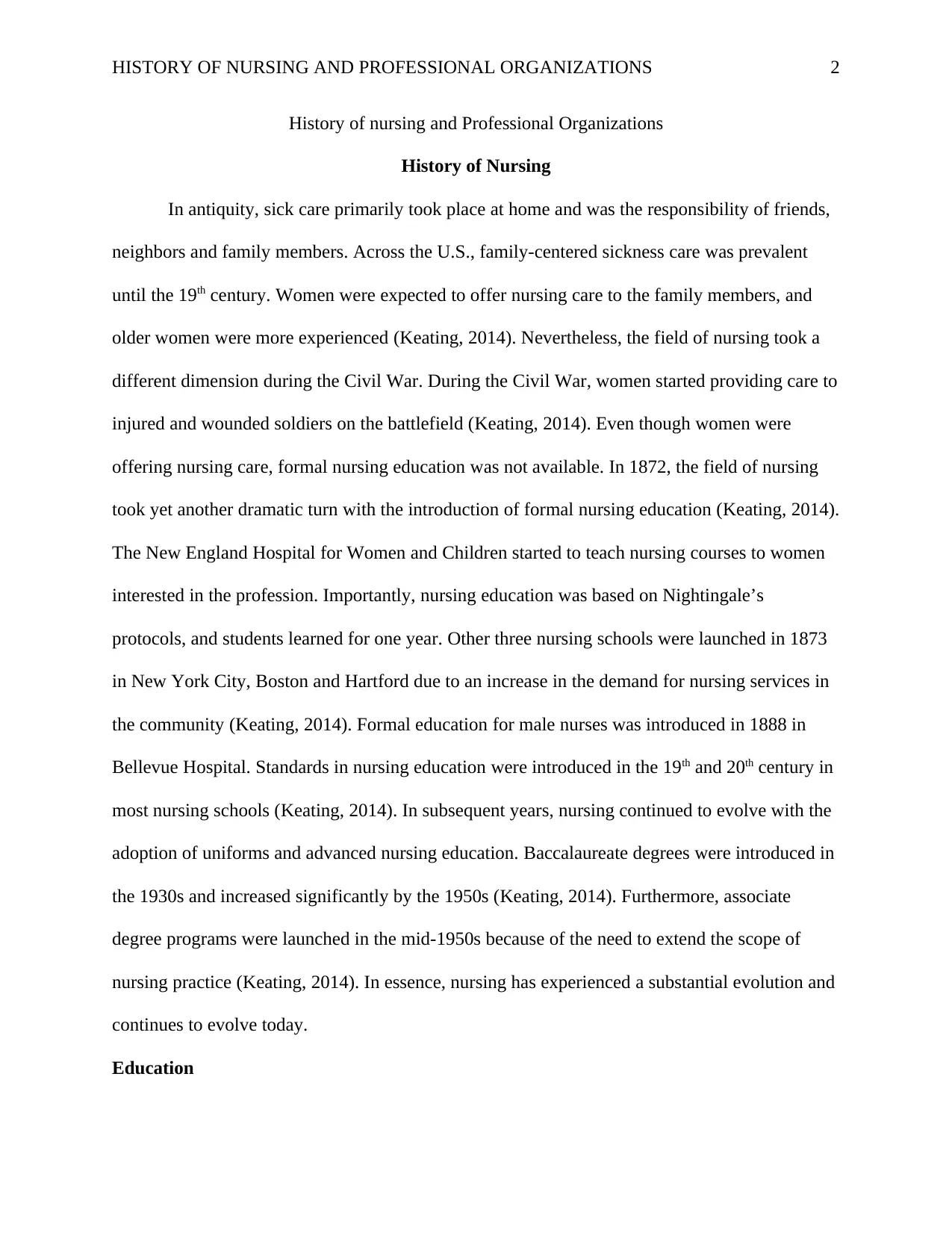
HISTORY OF NURSING AND PROFESSIONAL ORGANIZATIONS 2
History of nursing and Professional Organizations
History of Nursing
In antiquity, sick care primarily took place at home and was the responsibility of friends,
neighbors and family members. Across the U.S., family-centered sickness care was prevalent
until the 19th century. Women were expected to offer nursing care to the family members, and
older women were more experienced (Keating, 2014). Nevertheless, the field of nursing took a
different dimension during the Civil War. During the Civil War, women started providing care to
injured and wounded soldiers on the battlefield (Keating, 2014). Even though women were
offering nursing care, formal nursing education was not available. In 1872, the field of nursing
took yet another dramatic turn with the introduction of formal nursing education (Keating, 2014).
The New England Hospital for Women and Children started to teach nursing courses to women
interested in the profession. Importantly, nursing education was based on Nightingale’s
protocols, and students learned for one year. Other three nursing schools were launched in 1873
in New York City, Boston and Hartford due to an increase in the demand for nursing services in
the community (Keating, 2014). Formal education for male nurses was introduced in 1888 in
Bellevue Hospital. Standards in nursing education were introduced in the 19th and 20th century in
most nursing schools (Keating, 2014). In subsequent years, nursing continued to evolve with the
adoption of uniforms and advanced nursing education. Baccalaureate degrees were introduced in
the 1930s and increased significantly by the 1950s (Keating, 2014). Furthermore, associate
degree programs were launched in the mid-1950s because of the need to extend the scope of
nursing practice (Keating, 2014). In essence, nursing has experienced a substantial evolution and
continues to evolve today.
Education
History of nursing and Professional Organizations
History of Nursing
In antiquity, sick care primarily took place at home and was the responsibility of friends,
neighbors and family members. Across the U.S., family-centered sickness care was prevalent
until the 19th century. Women were expected to offer nursing care to the family members, and
older women were more experienced (Keating, 2014). Nevertheless, the field of nursing took a
different dimension during the Civil War. During the Civil War, women started providing care to
injured and wounded soldiers on the battlefield (Keating, 2014). Even though women were
offering nursing care, formal nursing education was not available. In 1872, the field of nursing
took yet another dramatic turn with the introduction of formal nursing education (Keating, 2014).
The New England Hospital for Women and Children started to teach nursing courses to women
interested in the profession. Importantly, nursing education was based on Nightingale’s
protocols, and students learned for one year. Other three nursing schools were launched in 1873
in New York City, Boston and Hartford due to an increase in the demand for nursing services in
the community (Keating, 2014). Formal education for male nurses was introduced in 1888 in
Bellevue Hospital. Standards in nursing education were introduced in the 19th and 20th century in
most nursing schools (Keating, 2014). In subsequent years, nursing continued to evolve with the
adoption of uniforms and advanced nursing education. Baccalaureate degrees were introduced in
the 1930s and increased significantly by the 1950s (Keating, 2014). Furthermore, associate
degree programs were launched in the mid-1950s because of the need to extend the scope of
nursing practice (Keating, 2014). In essence, nursing has experienced a substantial evolution and
continues to evolve today.
Education
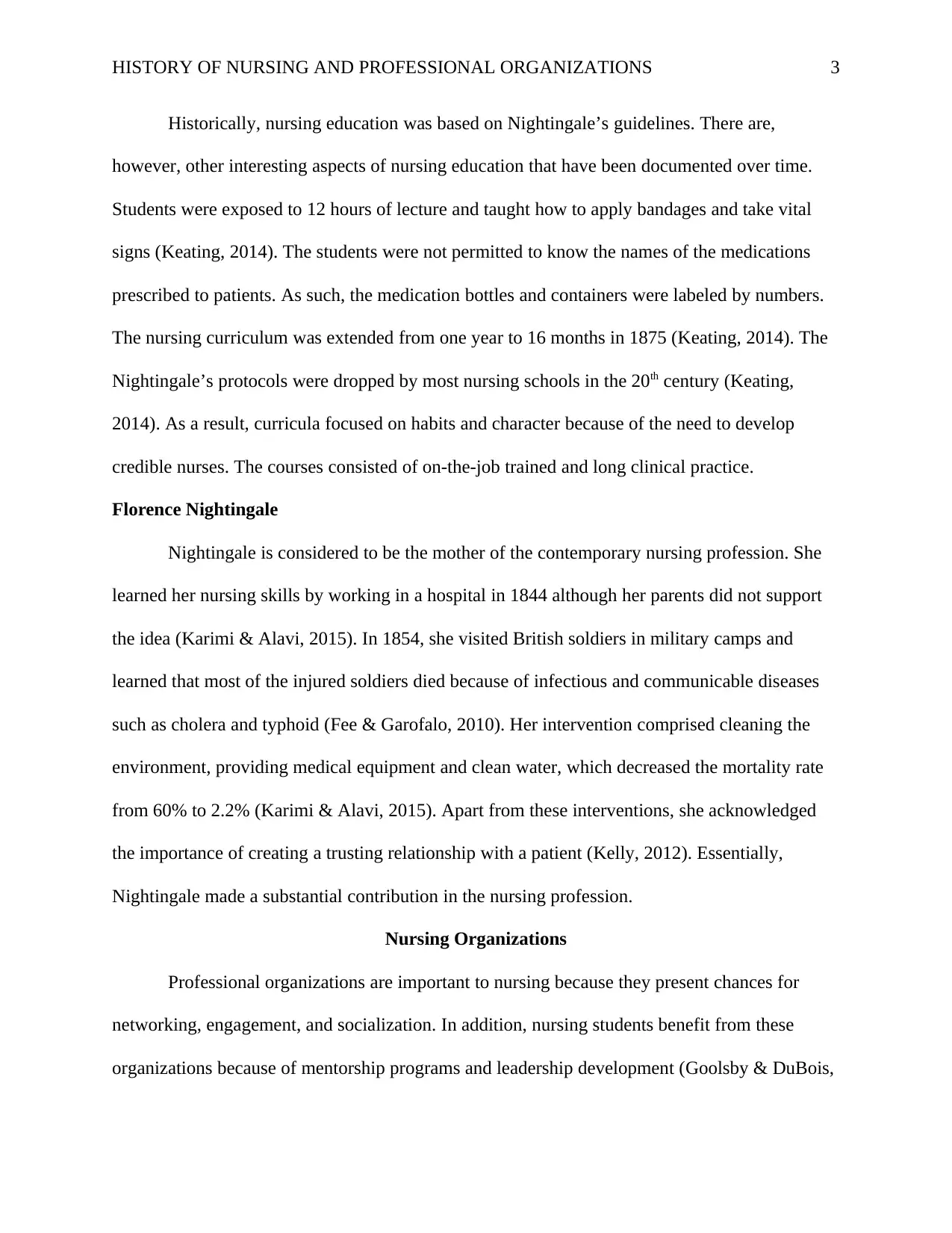
HISTORY OF NURSING AND PROFESSIONAL ORGANIZATIONS 3
Historically, nursing education was based on Nightingale’s guidelines. There are,
however, other interesting aspects of nursing education that have been documented over time.
Students were exposed to 12 hours of lecture and taught how to apply bandages and take vital
signs (Keating, 2014). The students were not permitted to know the names of the medications
prescribed to patients. As such, the medication bottles and containers were labeled by numbers.
The nursing curriculum was extended from one year to 16 months in 1875 (Keating, 2014). The
Nightingale’s protocols were dropped by most nursing schools in the 20th century (Keating,
2014). As a result, curricula focused on habits and character because of the need to develop
credible nurses. The courses consisted of on-the-job trained and long clinical practice.
Florence Nightingale
Nightingale is considered to be the mother of the contemporary nursing profession. She
learned her nursing skills by working in a hospital in 1844 although her parents did not support
the idea (Karimi & Alavi, 2015). In 1854, she visited British soldiers in military camps and
learned that most of the injured soldiers died because of infectious and communicable diseases
such as cholera and typhoid (Fee & Garofalo, 2010). Her intervention comprised cleaning the
environment, providing medical equipment and clean water, which decreased the mortality rate
from 60% to 2.2% (Karimi & Alavi, 2015). Apart from these interventions, she acknowledged
the importance of creating a trusting relationship with a patient (Kelly, 2012). Essentially,
Nightingale made a substantial contribution in the nursing profession.
Nursing Organizations
Professional organizations are important to nursing because they present chances for
networking, engagement, and socialization. In addition, nursing students benefit from these
organizations because of mentorship programs and leadership development (Goolsby & DuBois,
Historically, nursing education was based on Nightingale’s guidelines. There are,
however, other interesting aspects of nursing education that have been documented over time.
Students were exposed to 12 hours of lecture and taught how to apply bandages and take vital
signs (Keating, 2014). The students were not permitted to know the names of the medications
prescribed to patients. As such, the medication bottles and containers were labeled by numbers.
The nursing curriculum was extended from one year to 16 months in 1875 (Keating, 2014). The
Nightingale’s protocols were dropped by most nursing schools in the 20th century (Keating,
2014). As a result, curricula focused on habits and character because of the need to develop
credible nurses. The courses consisted of on-the-job trained and long clinical practice.
Florence Nightingale
Nightingale is considered to be the mother of the contemporary nursing profession. She
learned her nursing skills by working in a hospital in 1844 although her parents did not support
the idea (Karimi & Alavi, 2015). In 1854, she visited British soldiers in military camps and
learned that most of the injured soldiers died because of infectious and communicable diseases
such as cholera and typhoid (Fee & Garofalo, 2010). Her intervention comprised cleaning the
environment, providing medical equipment and clean water, which decreased the mortality rate
from 60% to 2.2% (Karimi & Alavi, 2015). Apart from these interventions, she acknowledged
the importance of creating a trusting relationship with a patient (Kelly, 2012). Essentially,
Nightingale made a substantial contribution in the nursing profession.
Nursing Organizations
Professional organizations are important to nursing because they present chances for
networking, engagement, and socialization. In addition, nursing students benefit from these
organizations because of mentorship programs and leadership development (Goolsby & DuBois,
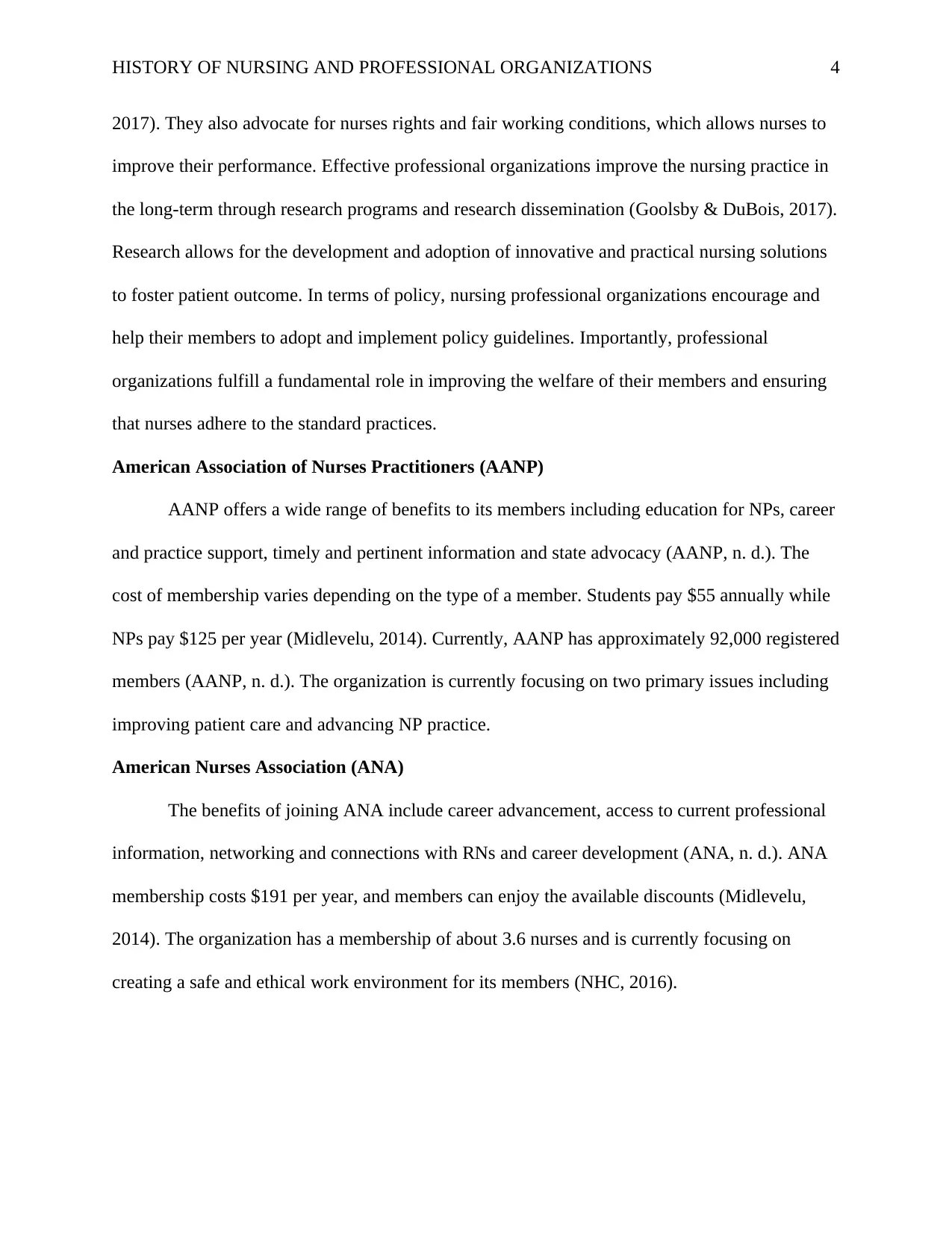
HISTORY OF NURSING AND PROFESSIONAL ORGANIZATIONS 4
2017). They also advocate for nurses rights and fair working conditions, which allows nurses to
improve their performance. Effective professional organizations improve the nursing practice in
the long-term through research programs and research dissemination (Goolsby & DuBois, 2017).
Research allows for the development and adoption of innovative and practical nursing solutions
to foster patient outcome. In terms of policy, nursing professional organizations encourage and
help their members to adopt and implement policy guidelines. Importantly, professional
organizations fulfill a fundamental role in improving the welfare of their members and ensuring
that nurses adhere to the standard practices.
American Association of Nurses Practitioners (AANP)
AANP offers a wide range of benefits to its members including education for NPs, career
and practice support, timely and pertinent information and state advocacy (AANP, n. d.). The
cost of membership varies depending on the type of a member. Students pay $55 annually while
NPs pay $125 per year (Midlevelu, 2014). Currently, AANP has approximately 92,000 registered
members (AANP, n. d.). The organization is currently focusing on two primary issues including
improving patient care and advancing NP practice.
American Nurses Association (ANA)
The benefits of joining ANA include career advancement, access to current professional
information, networking and connections with RNs and career development (ANA, n. d.). ANA
membership costs $191 per year, and members can enjoy the available discounts (Midlevelu,
2014). The organization has a membership of about 3.6 nurses and is currently focusing on
creating a safe and ethical work environment for its members (NHC, 2016).
2017). They also advocate for nurses rights and fair working conditions, which allows nurses to
improve their performance. Effective professional organizations improve the nursing practice in
the long-term through research programs and research dissemination (Goolsby & DuBois, 2017).
Research allows for the development and adoption of innovative and practical nursing solutions
to foster patient outcome. In terms of policy, nursing professional organizations encourage and
help their members to adopt and implement policy guidelines. Importantly, professional
organizations fulfill a fundamental role in improving the welfare of their members and ensuring
that nurses adhere to the standard practices.
American Association of Nurses Practitioners (AANP)
AANP offers a wide range of benefits to its members including education for NPs, career
and practice support, timely and pertinent information and state advocacy (AANP, n. d.). The
cost of membership varies depending on the type of a member. Students pay $55 annually while
NPs pay $125 per year (Midlevelu, 2014). Currently, AANP has approximately 92,000 registered
members (AANP, n. d.). The organization is currently focusing on two primary issues including
improving patient care and advancing NP practice.
American Nurses Association (ANA)
The benefits of joining ANA include career advancement, access to current professional
information, networking and connections with RNs and career development (ANA, n. d.). ANA
membership costs $191 per year, and members can enjoy the available discounts (Midlevelu,
2014). The organization has a membership of about 3.6 nurses and is currently focusing on
creating a safe and ethical work environment for its members (NHC, 2016).
Secure Best Marks with AI Grader
Need help grading? Try our AI Grader for instant feedback on your assignments.
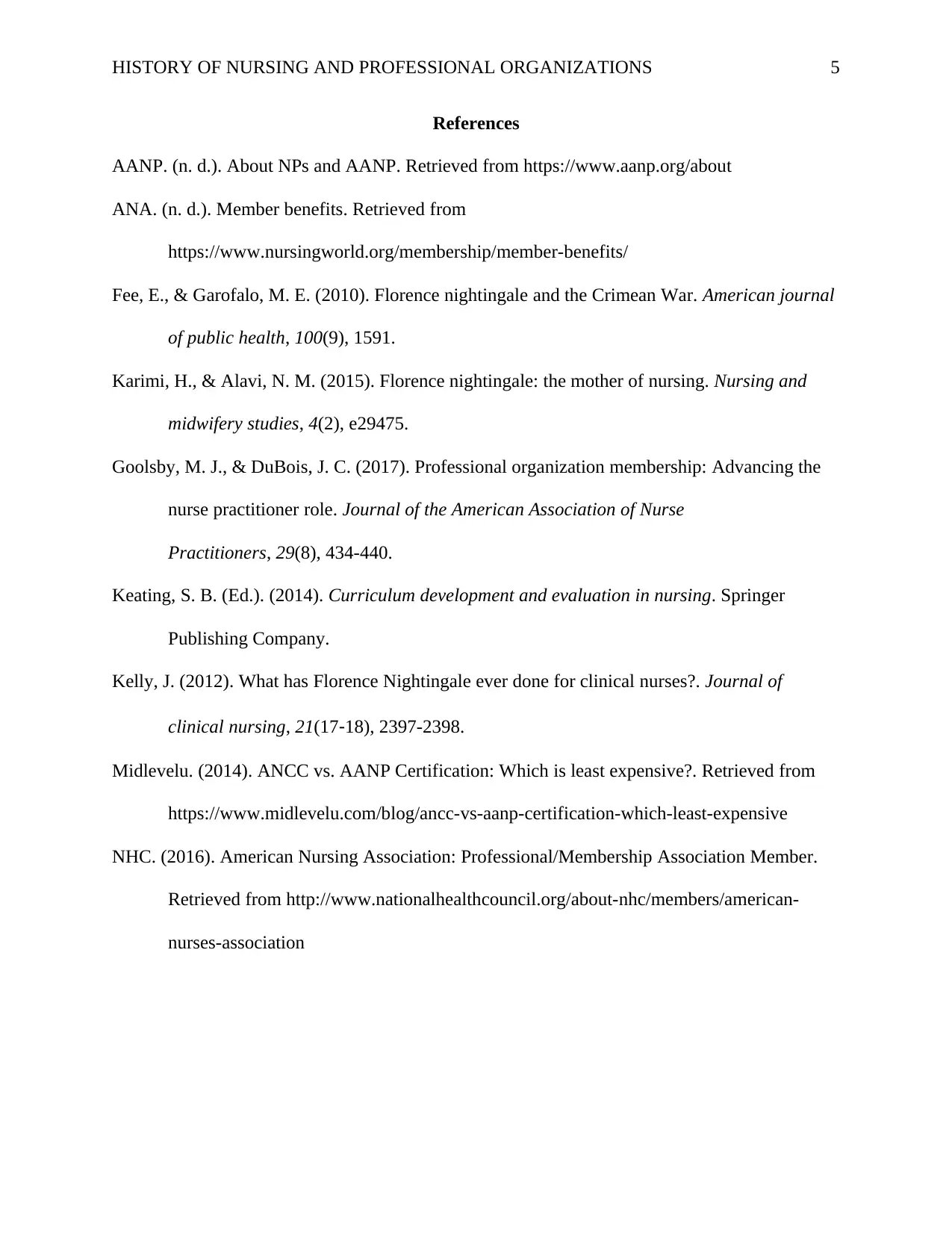
HISTORY OF NURSING AND PROFESSIONAL ORGANIZATIONS 5
References
AANP. (n. d.). About NPs and AANP. Retrieved from https://www.aanp.org/about
ANA. (n. d.). Member benefits. Retrieved from
https://www.nursingworld.org/membership/member-benefits/
Fee, E., & Garofalo, M. E. (2010). Florence nightingale and the Crimean War. American journal
of public health, 100(9), 1591.
Karimi, H., & Alavi, N. M. (2015). Florence nightingale: the mother of nursing. Nursing and
midwifery studies, 4(2), e29475.
Goolsby, M. J., & DuBois, J. C. (2017). Professional organization membership: Advancing the
nurse practitioner role. Journal of the American Association of Nurse
Practitioners, 29(8), 434-440.
Keating, S. B. (Ed.). (2014). Curriculum development and evaluation in nursing. Springer
Publishing Company.
Kelly, J. (2012). What has Florence Nightingale ever done for clinical nurses?. Journal of
clinical nursing, 21(17‐18), 2397-2398.
Midlevelu. (2014). ANCC vs. AANP Certification: Which is least expensive?. Retrieved from
https://www.midlevelu.com/blog/ancc-vs-aanp-certification-which-least-expensive
NHC. (2016). American Nursing Association: Professional/Membership Association Member.
Retrieved from http://www.nationalhealthcouncil.org/about-nhc/members/american-
nurses-association
References
AANP. (n. d.). About NPs and AANP. Retrieved from https://www.aanp.org/about
ANA. (n. d.). Member benefits. Retrieved from
https://www.nursingworld.org/membership/member-benefits/
Fee, E., & Garofalo, M. E. (2010). Florence nightingale and the Crimean War. American journal
of public health, 100(9), 1591.
Karimi, H., & Alavi, N. M. (2015). Florence nightingale: the mother of nursing. Nursing and
midwifery studies, 4(2), e29475.
Goolsby, M. J., & DuBois, J. C. (2017). Professional organization membership: Advancing the
nurse practitioner role. Journal of the American Association of Nurse
Practitioners, 29(8), 434-440.
Keating, S. B. (Ed.). (2014). Curriculum development and evaluation in nursing. Springer
Publishing Company.
Kelly, J. (2012). What has Florence Nightingale ever done for clinical nurses?. Journal of
clinical nursing, 21(17‐18), 2397-2398.
Midlevelu. (2014). ANCC vs. AANP Certification: Which is least expensive?. Retrieved from
https://www.midlevelu.com/blog/ancc-vs-aanp-certification-which-least-expensive
NHC. (2016). American Nursing Association: Professional/Membership Association Member.
Retrieved from http://www.nationalhealthcouncil.org/about-nhc/members/american-
nurses-association
1 out of 5
Related Documents
Your All-in-One AI-Powered Toolkit for Academic Success.
+13062052269
info@desklib.com
Available 24*7 on WhatsApp / Email
![[object Object]](/_next/static/media/star-bottom.7253800d.svg)
Unlock your academic potential
© 2024 | Zucol Services PVT LTD | All rights reserved.





